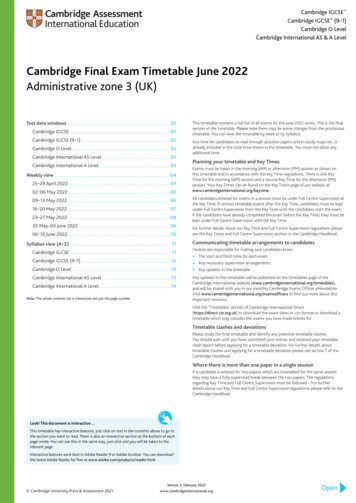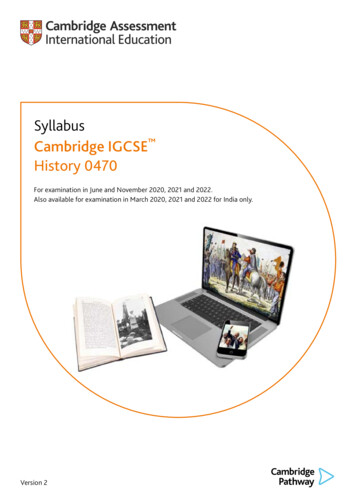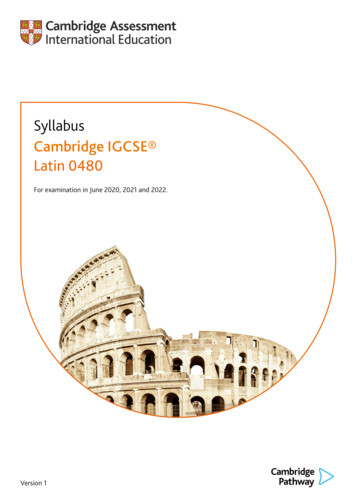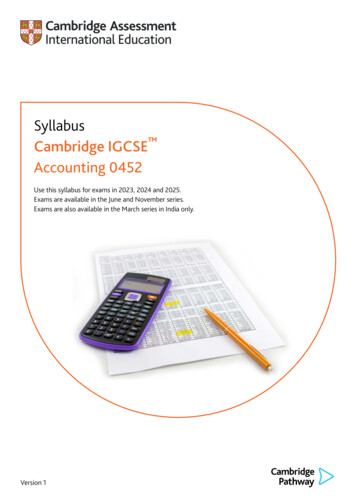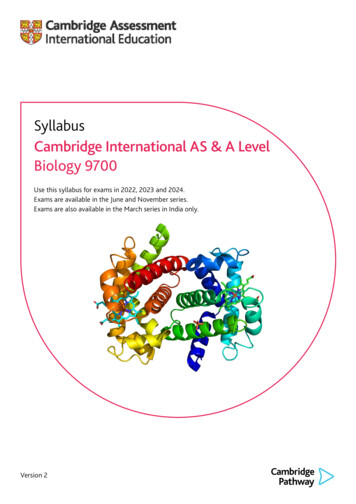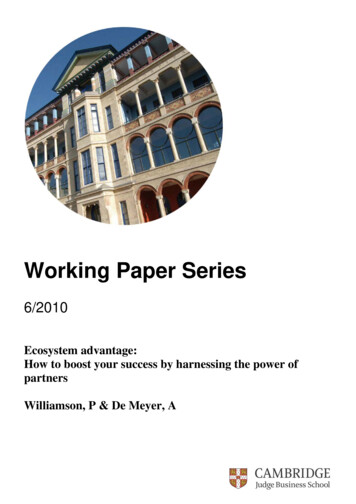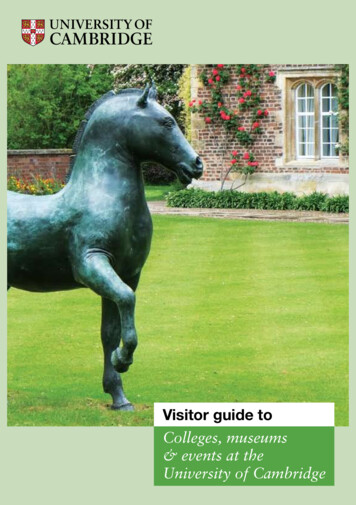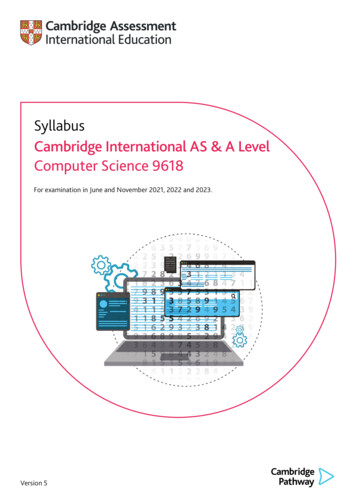
Transcription
SyllabusCambridge International AS & A LevelComputer Science 9618For examination in June and November 2021, 2022 and 2023.Version 5
Why choose Cambridge International?Cambridge Assessment International Education prepares school students for life, helping them develop an informedcuriosity and a lasting passion for learning. We are part of the University of Cambridge.Our Cambridge Pathway gives students a clear path for educational success from age 5 to 19. Schools can shapethe curriculum around how they want students to learn – with a wide range of subjects and flexible ways to offerthem. It helps students discover new abilities and a wider world, and gives them the skills they need for life, so theycan achieve at school, university and work.Our programmes and qualifications set the global standard for international education. They are created by subjectexperts, rooted in academic rigour and reflect the latest educational research. They provide a strong platform forstudents to progress from one stage to the next, and are well supported by teaching and learning resources.We review all our syllabuses regularly, so they reflect the latest research evidence and professional teachingpractice – and take account of the different national contexts in which they are taught.We consult with teachers to help us design each syllabus around the needs of their learners. Consulting withleading universities has helped us make sure our syllabuses encourage students to master the key concepts in thesubject and develop the skills necessary for success in higher education.Our mission is to provide educational benefit through provision of international programmes and qualifications forschool education and to be the world leader in this field. Together with schools, we develop Cambridge learnerswho are confident, responsible, reflective, innovative and engaged – equipped for success in the modern world.Every year, nearly a million Cambridge students from 10 000 schools in 160 countries prepare for their future withthe Cambridge Pathway.‘We think the Cambridge curriculum is superb preparation for university.’Christoph Guttentag, Dean of Undergraduate Admissions, Duke University, USAQuality managementCambridge International is committed to providing exceptional quality. In line with this commitment, ourquality management system for the provision of international qualifications and education programmes forstudents aged 5 to 19 is independently certified as meeting the internationally recognised standard,ISO 9001:2015. Learn more at www.cambridgeinternational.org/ISO9001Copyright UCLES September 2018Cambridge Assessment International Education is part of the Cambridge Assessment Group. Cambridge Assessment is the brand name ofthe University of Cambridge Local Examinations Syndicate (UCLES), which itself is a department of the University of Cambridge.UCLES retains the copyright on all its publications. Registered centres are permitted to copy material from this booklet for their owninternal use. However, we cannot give permission to centres to photocopy any material that is acknowledged to a third party even forinternal use within a centre.
Contents1 Why choose this syllabus? .22 Syllabus overview . 6Aims6Content overview6Assessment overview8Assessment objectives103 Subject content . 11AS Content11A Level Content27Teacher Guidance334 Details of the assessment .34Submission of Paper 4 Practical34Command words355 What else you need to know . 36Before you start36Making entries37After the exam38How students, teachers and higher education can use the grades39Grade descriptions39Changes to this syllabus for 2021, 2022 and 202340Changes to this syllabusFor information about changes to this syllabus for 2021, 2022 and 2023, go to page 40.
Cambridge International AS & A Level Computer Science 9618 syllabus for 2021, 2022 and 2023.1 Why choose this syllabus?Key benefitsThe best motivation for a student is a real passion for the subjectthey’re learning. By offering students a variety of CambridgeInternational AS & A Levels, you can give them the greatest chanceof finding the path of education they most want to follow. Withover 50 subjects to choose from, students can select the onesthey love and that they’re best at, which helps motivate themthroughout their studies.Following a Cambridge International AS & A Level programmehelps students develop abilities which universities value highly,including: a deep understanding of their subjects higher order thinking skills such as analysis, critical thinking,problem solving presenting ordered and coherent arguments independent learning and research.Cambridge International AS & A Level Computer Science encourages learners to meet the needs of HigherEducation courses in computer science as well as twenty-first century digital employers. It encourages learnersto think creatively, through applying practical programming solutions, demonstrating that they are effectiveusers of technology.Our approach in Cambridge International AS & A Level Computer Science encourages learners to be:confident, using a range of technology and programming paradigmsresponsible, using technology ethicallyreflective, as programmers, improving their own programming solutioninnovative, creating efficient solutions to problemsengaged, in technology, how it is built and how software solutions are developed.‘Cambridge students develop a deep understanding of subjects and independent thinking skills.’Tony Hines, Principal, Rockledge High School, USA2www.cambridgeinternational.org/alevelBack to contents page
Cambridge International AS & A Level Computer Science 9618 syllabus for 2021, 2022 and 2023. Why choose this syllabus?Key conceptsKey concepts are essential ideas that help students develop a deep understanding of their subject and make linksbetween different aspects. Key concepts may open up new ways of thinking about, understanding or interpretingthe important things to be learned.Good teaching and learning will incorporate and reinforce a subject’s key concepts to help students gain: a greater depth as well as breadth of subject knowledge confidence, especially in applying knowledge and skills in new situations the vocabulary to discuss their subject conceptually and show how different aspects link together a level of mastery of their subject to help them enter higher education.The key concepts identified below, carefully introduced and developed, will help to underpin the course you willteach. You may identify additional key concepts which will also enrich teaching and learning.The key concepts for Cambridge International AS & A Level Computer Science are: Computational thinkingComputational thinking is a set of fundamental skills that help produce a solution to a problem. Skills such asabstraction, decomposition and algorithmic thinking are used to study a problem and design a solution that canbe implemented. This may involve using a range of technologies and programming languages. Programming paradigmsA programming paradigm is a way of thinking about or approaching problems. There are many differentprogramming styles that can be used, which are suited to unique functions, tools and specific situations. Anunderstanding of programming paradigms is essential to ensure they are used appropriately, when designingand building programs. CommunicationCommunication is a core requirement of computer systems. It includes the ability to transfer data from onedevice or component to another and an understanding of the rules and methods that are used in this datatransfer. Communication could range from the internal transfer of data within a computer system, to thetransfer of a video across the internet. Computer architecture and hardwareComputer architecture is the design of the internal operation of a computer system. It includes the rulesthat dictate how components and data are organised, how data are communicated between components, toallow hardware to function. There is a range of architectures, with different components and rules, that areappropriate for different scenarios.All computers comprise of a combination of hardware components, ranging from internal components, suchas the Central Processing Unit (CPU) and main memory, to peripherals. To produce effective and efficientprograms to run on hardware, it is important to understand how the components work independently andtogether to produce a system that can be used. Hardware needs software to be able to perform a task.Software allows hardware to become functional. This enables the user to communicate with the hardware toperform tasks. Data representation and structuresComputers use binary and understanding how a binary number can be interpreted in many different ways isimportant. Programming requires an understanding of how data can be organised for efficient access and/ortransfer.Back to contents pagewww.cambridgeinternational.org/alevel3
Cambridge International AS & A Level Computer Science 9618 syllabus for 2021, 2022 and 2023. Why choose this syllabus?Recognition and progressionOur expertise in curriculum, teaching and learning, and assessment is the basis for the recognition of ourprogrammes and qualifications around the world. Every year thousands of students with Cambridge InternationalAS & A Levels gain places at leading universities worldwide. They are valued by top universities around the worldincluding those in the UK, US (including Ivy League universities), Europe, Australia, Canada and New Zealand.UK NARIC, the national agency in the UK for the recognition and comparison of international qualifications andskills, has carried out an independent benchmarking study of Cambridge International AS & A Level and found it tobe comparable to the standard of AS & A Level in the UK. This means students can be confident that their CambridgeInternational AS & A Level qualifications are accepted as equivalent, grade for grade, to UK AS & A Levels by leadinguniversities worldwide.Cambridge International AS Level Computer Science makes up the first half of the Cambridge InternationalA Level course in Computer Science and provides a foundation for the study of Computer Science at CambridgeInternational A Level. Depending on local university entrance requirements, students may be able to use it toprogress directly to university courses in Computer Science or some other subjects. It is also suitable as part of acourse of general education.Cambridge International A Level Computer Science provides a foundation for the study of Computer Science orrelated courses in higher education. Equally it is suitable as part of a course of general education.For more information about the relationship between the Cambridge International AS Level and CambridgeInternational A Level see the ‘Assessment overview’ section of the Syllabus overview.We recommend learners check the Cambridge recognitions database and the university websites to find the mostup-to-date entry requirements for courses they wish to study.Learn more at www.cambridgeinternational.org/recognition‘The depth of knowledge displayed by the best A Level students makes them prime targets forAmerica’s Ivy League universities’Yale University, USA4www.cambridgeinternational.org/alevelBack to contents page
Cambridge International AS & A Level Computer Science 9618 syllabus for 2021, 2022 and 2023. Why choose this syllabus?Supporting teachersWe provide a wide range of practical resources, detailed guidance, and innovative training and professionaldevelopment so that you can give your learners the best possible preparation for Cambridge InternationalAS & A Level.Teaching resourcesExam preparation resources School Support Hubwww.cambridgeinternational.org/support Question papers Syllabuses Schemes of work Example candidate responses to understandwhat examiners are looking for at key grades Learner guides Examiner reports to improve future teaching Mark schemes Discussion forums Endorsed resourcesTraining Introductory – face-to-face or online Extension – face-to-face or online Enrichment – face-to-face or online Coursework – online Cambridge Professional DevelopmentQualificationsSupportfor CambridgeInternationalAS & A LevelCommunityYou can find useful information, as well asshare your ideas and experiences with otherteachers, on our social media channels andcommunity forums.Find out more atwww.cambridgeinternational.org/social-mediaFind out more atwww.cambridgeinternational.org/profdevIn addition, a pseudo code guide supports Cambridge International AS & A Level Computer Science (9618)to ensure that teachers and learners are familiar with the style used in examinations. This can be found ge International AS & A Levels prepare students well for university because they’velearnt to go into a subject in considerable depth. There’s that ability to really understand thedepth and richness and the detail of a subject. It’s a wonderful preparation for what they aregoing to face at university.’US Higher Education Advisory CouncilBack to contents pagewww.cambridgeinternational.org/alevel5
Cambridge International AS & A Level Computer Science 9618 syllabus for 2021, 2022 and 2023.2 Syllabus overviewAimsThe aims of this course are to enable students to develop: computational thinking skills an understanding of the main principles of solving problems using computers an understanding of the component parts of computer systems and how they interrelate, including software,data, hardware, communication and people an understanding of the different methods of communication and the functionality of networks and the internet the skills necessary to apply this understanding to develop computer based solutions to problemsContent overviewAS Level Content1Information representation1.1Data Representation1.2Multimedia – Graphics, Sound1.3Compression2Communication2.1Networks including the internet3Hardware3.1Computers and their components3.2 Logic Gates and Logic Circuits44.1 Central Processing Unit (CPU) ArchitectureProcessor Fundamentals4.2 Assembly Language4.3 Bit manipulation55.1System Software5.2 Language Translators66.1 Data SecuritySecurity, privacy and data integrity6.2 Data Integrity7Ethics and Ownership7.18Databases8.1 Database ConceptsEthics and Ownership8.2 Database Management System (DBMS)8.3 Data Definition Language (DDL) and Data ManipulationLanguage (DML)99.1 Computational Thinking SkillsAlgorithm Design and Problem-Solving6Operating Systemwww.cambridgeinternational.org/alevel9.2 AlgorithmsBack to contents page
Cambridge International AS & A Level Computer Science 9618 syllabus for 2021, 2022 and 2023. Syllabus overview10 Data Types and structures10.1 Data Types and Records10.2 Arrays10.3 Files10.4 Introduction to Abstract Data Types (ADT)11 Programming11.1 Programming Basics11.2 Constructs11.3 Structured Programming12 Software Development12.1 Program Development Lifecycle12.2 Program Design12.3 Program Testing and maintenanceA Level Content13 Data Representation13.1 User-defined data types13.2 File organisation and access13.3 Floating-point numbers, representation andmanipulation14 Communication and internet technologies14.1 Protocols14.2 Circuit switching, packet switching15 Hardware and Virtual Machines15.1 Processers, Parallel Processing and Virtual Machines15.2 Boolean Algebra and Logic Circuits16 System Software16.1 Purposes of an Operating System (OS)16.2 Translation Software17 Security17.1 Encryption, Encryption Protocols and Digital certificates18 Artificial Intelligence (AI)18.1 Artificial Intelligence19 Computational thinking and problem solving19.1 Algorithms19.2 Recursion20 Further Programming20.1 Programming Paradigms20.2 File Processing and Exception HandlingSupport for Cambridge International AS & A Level Computer ScienceOur School Support Hub www.cambridgeinternational.org/support provides Cambridge schools with asecure site for downloading specimen and past question papers, mark schemes, grade thresholds and othercurriculum resources specific to this syllabus. The School Support Hub community offers teachers theopportunity to connect with each other and to ask questions related to the syllabus.Back to contents pagewww.cambridgeinternational.org/alevel7
Cambridge International AS & A Level Computer Science 9618 syllabus for 2021, 2022 and 2023. Syllabus overviewAssessment overviewAt AS Level candidates take papers 1 and 2. At A Level candidates take all four papers. Calculators must not be usedin any paper.Paper 1 Theory FundamentalsPaper 3 Advanced Theory1 hour 30 minutes1 hour 30 minutes75 marks75 marksPaper 1 will assess sections 1 to 8 of thesyllabus content.Paper 3 will assess sections 13 to 20 of thesyllabus content.Written paper.Written paper.Externally assessed. Candidates answer allquestions.Externally assessed. Candidates answer allquestions.50% of the AS Level25% of the A Level25% of the A LevelPaper 2 Fundamental Problem-solving andProgramming SkillsPaper 4 Practical2 hours75 marks75 marksPaper 2 will assess sections 9 to 12 of thesyllabus content.Paper 4 will assess sections 19 to 20 of thesyllabus content, except for low-level anddeclarative programming.Candidates will need to write answers inpseudocode.82 hours 30 minutesWritten paper.Candidates will submit complete programcode and evidence of testing.Externally assessed. Candidates answer allquestions.Candidates will be required to use either Java,VB.NET or Python programming languages.50% of the AS LevelExternally assessed. Candidates answer allquestions on a computer without internet oremail facility.25% of the A Level25% of the A Levelwww.cambridgeinternational.org/alevelBack to contents page
Cambridge International AS & A Level Computer Science 9618 syllabus for 2021, 2022 and 2023. Syllabus overviewThere are three routes for Cambridge International AS & A Level Computer Science:Route12AS Level only(Candidates take all AS componentsin the same exam series)A Level (staged over two years)Year 1 AS Level*Paper 1Paper 2 Year 2 Complete the A Level3A Level(Candidates take all components inthe same exam series) Paper 3Paper 4 * Candidates carry forward their AS Level result subject to the rules and time limits described in the Cambridge Handbook.Candidates following an AS Level route will be eligible for grades a–e. Candidates following an A Level route areeligible for grades A*–E.Back to contents pagewww.cambridgeinternational.org/alevel9
Cambridge International AS & A Level Computer Science 9618 syllabus for 2021, 2022 and 2023. Syllabus overviewAssessment objectivesThe assessment objectives (AOs) are:AO1: Demonstrate knowledge and understanding of the principles and concepts ofcomputer science, including abstraction, logic, algorithms and data representation.AO2: Apply knowledge and understanding of the principles and concepts ofcomputer science, including to analyse problems in computational terms.AO3: Design, program and evaluate computer systems to solve problems, makingreasoned judgements about these.Weighting for assessment objectivesThe approximate weightings allocated to each of the assessment objectives (AOs) are summarised below.Assessment objectives as a percentage of each qualificationAssessment objectiveWeighting in AS Level %Weighting in A Level %AO13030AO24030AO33040Total100100Assessment objectives as a percentage of each componentAssessment objective10Weighting in components %Paper 1Paper 2Paper 3Paper 0100100www.cambridgeinternational.org/alevelBack to contents page
Cambridge International AS & A Level Computer Science 9618 syllabus for 2021, 2022 and 2023. Subject content3 Subject contentAS ContentComputational thinking is developed using a structured approach that includes the use of programming andproblem solving skills to provide solutions to real life problems. It requires the manipulation and storage ofdifferent types of data and the communication of solutions over networks.Computational thinking is supported by developing an understanding of how computer architecture, hardware,systems software, security measures and communication systems, provide the infrastructure required in an efficientand ethical way. The syllabus supports opportunities for students to apply their skills in practical contexts that arerequired in the digital industry.1Information representation1.1Data RepresentationCandidates should be able to:Notes and guidanceShow understanding of binary magnitudes and thedifference between binary prefixes and decimalprefixesUnderstand the difference between and use:Show understanding of the basis of different numbersystems kibi and kilo mebi and mega gibi and giga tebi and teraUse the binary, denary, hexadecimal number basesand Binary Coded Decimal (BCD) and one’s and two’scomplement representation for binary numbersConvert an integer value from one number base /representation to anotherPerform binary addition and subtractionUsing positive and negative binary integersShow understanding of how overflow can occurDescribe practical applications where Binary CodedDecimal (BCD) and Hexadecimal are usedShow understanding of and be able to representcharacter data in its internal binary form, dependingon the character set usedBack to contents pageFamiliar with ASCII (American Standard Code forInformation Interchange), extended ASCII andUnicode. Students will not be expected to memoriseany particular character codeswww.cambridgeinternational.org/alevel11
Cambridge International AS & A Level Computer Science 9618 syllabus for 2021, 2022 and 2023.1.2 MultimediaGraphicsCandidates should be able to:Notes and guidanceShow understanding of how data for a bitmappedimage are encodedUse and understand the terms: pixel, file header,image resolution, screen resolution, colour depth/bitdepthPerform calculations to estimate the file size for abitmap imageShow understanding of the effects of changingelements of a bitmap image on the image quality andfile sizeUse the terms: image resolution, colour depth/bitdepthShow understanding of how data for a vector graphicare encodedUse the terms: drawing object, property, drawing listJustify the use of a bitmap image or a vector graphicfor a given taskSoundCandidates should be able to:Notes and guidanceShow understanding of how sound is represented andencodedUse the terms: sampling, sampling rate, samplingresolution, analogue and digital dataShow understanding of the impact of changing thesampling rate and resolutionImpact on file size and accuracy1.3 CompressionCandidates should be able to:Notes and guidanceShow understanding of the need for and examples ofthe use of compressionShow understanding of lossy and lossless compressionand justify the use of a method in a given situationShow understanding of how a text file, bitmap image,vector graphic and sound file can be ncluding the use of run-length encoding (RLE)Back to contents page
Cambridge International AS & A Level Computer Science 9618 syllabus for 2021, 2022 and 2023. Subject content2Communication2.1 Networks including the internetCandidates should be able to:Notes and guidanceShow understanding of the purpose and benefits ofnetworking devicesShow understanding of the characteristics of a LAN(local area network) and a WAN (wide area network)Explain the client-server and peer-to-peer models ofnetworked computersRoles of the different computers within the networkand subnetwork modelsBenefits and drawbacks of each modelJustify the use of a model for a given situationShow understanding of thin-client and thick-clientand the differences between themShow understanding of the bus, star, mesh and hybridtopologiesUnderstand how packets are transmitted betweentwo hosts for a given topologyJustify the use of a topology for a given situationShow understanding of cloud computingIncluding the use of public and private clouds.Benefits and drawbacks of cloud computingShow understanding of the differences between andimplications of the use of wireless and wired networksDescribe the characteristics of copper cable, fibreoptic cable, radio waves (including WiFi), microwaves,satellitesDescribe the hardware that is used to support a LANIncluding switch, server, Network Interface Card(NIC), Wireless Network Interface Card (WNIC),Wireless Access Points (WAP), cables, bridge, repeaterDescribe the role and function of a router in a networkShow understanding of Ethernet and how collisionsare detected and avoidedIncluding Carrier Sense Multiple Access / CollisionDetection (CSMA / CD)Show understanding of bit streamingMethods of bit streaming, i.e. real-time andon-demandImportance of bit rates / broadband speed on bitstreamingShow understanding of the differences between theWorld Wide Web (WWW) and the internetDescribe the hardware that is used to support theinternetBack to contents pageIncluding modems, PSTN (Public Switched TelephoneNetwork), dedicated lines, cell phone networkwww.cambridgeinternational.org/alevel13
Cambridge International AS & A Level Computer Science 9618 syllabus for 2021, 2022 and 2023. Subject content2.1 Networks including the internet continuedExplain the use of IP addresses in the transmission ofdata over the internetIncluding: format of an IP address including IPv4 and IPv6 use of subnetting in a network how an IP address is associated with a device on anetwork difference between a public IP address anda private IP address and the implications forsecurity difference between a static IP address and adynamic IP addressExplain how a Uniform Resource Locator (URL) is usedto locate a resource on the World Wide Web (WWW)and the role of the Domain Name Service (DNS)3Hardware3.1 Computers and their componentsCandidates should be able to:Notes and guidanceShow understanding of the need for input, output,primary memory and secondary (including removable)storageShow understanding of embedded systemsIncluding: benefits and drawbacks of embeddedsystemsDescribe the principal operations of hardware devicesIncluding: Laser printer, 3D printer, microphone,speakers, magnetic hard disk, solid state (flash)memory, optical disc reader/writer, touchscreen,virtual reality headsetShow understanding of the use of buffersExplain the differences between Random AccessMemory (RAM) and Read Only Memory (ROM)Including their use in a range of devices and systemsExplain the differences between Static RAM (SRAM)and Dynamic RAM (DRAM)Include their use in a range of devices and systemsand the reasons for using one instead of the otherdepending on the device and its useExplain the difference between Programmable ROM(PROM), Erasable Programmable ROM (EPROM) andElectrically Erasable Programmable ROM (EEPROM)Show an understanding of monitoring and velIncluding: difference between monitoring and control use of sensors (including temperature, pressure,infra-red, sound) and actuators importance of feedbackBack to contents page
Cambridge International AS & A Level Computer Science 9618 syllabus for 2021, 2022 and 2023. Subject content3.2 Logic Gates and Logic CircuitsCandidates should be able to:Notes and guidanceUse the following logic gate symbols:NOTANDORNANDNORXORUnderstand and define the functions of :NOT, AND, OR, NAND, NOR and XOR (EOR) gatesAll gates except the NOT gate will have two inputsonly.Construct the truth table for each of the logic gatesaboveConstruct a logic circuitConstruct a truth tableConstruct a logic expressionBack to contents pageFrom: a problem statement a logic expression a truth tableFrom: a problem statement a logic circuit a logic expressionFrom: a problem statement a logic circuit a truth tablewww.cambridgeinternational.org/alevel15
Cambridge International AS & A Level Computer Science 9618 syllabus for 2021, 2022 and 2023. Subject content4Processor Fundamentals4.1 Central Processing Unit (CPU) ArchitectureCandidates should be able to:Notes and guidanceShow understanding of the basic Von Neumannmodel for a computer system and the stored programconceptShow understanding of the purpose and role ofregisters, including the difference between generalpurpose and special purpose registersSpecial purpose registers including: Program Counter (PC) Memory Data Register (MDR) Memory Address Register (MAR) The Accumulator (ACC) Index Register (IX) Current Instruction Register (CIR) Status RegisterShow understanding of the purpose and roles of theArithmetic and Logic Unit (ALU), Control Unit (CU)and system clock, Immediate Access Store (IAS)Show understanding of how data are transferredbetween various components of the computer systemusing the address bus, data bus and control busShow understanding of how factors contribute to theperformance of the computer systemUnderstand how different ports provide connection toperipheral devices16Including: processor type and number of cores the bus width clock speed cache memoryIncluding connection to: Universal Serial Bus (USB) High Definition Multimedia Interface (HDMI) Video Graphics Array (VGA)Describe the stages of the Fetch-Execute (F-E) cycleDescribe and use ‘register transfer’ notation todescribe the F–E cycleShow understanding of the purpose of /alevel possible c
Changes to this syllabus for 2021, 2022 and 2023 40 Changes to this syllabus For information about changes to this syllabus for 2021, 2022 and 2023, go to page 40. . will help to underpin the course you will teach. You may identify additional key concepts which will also enrich teaching and learning.

